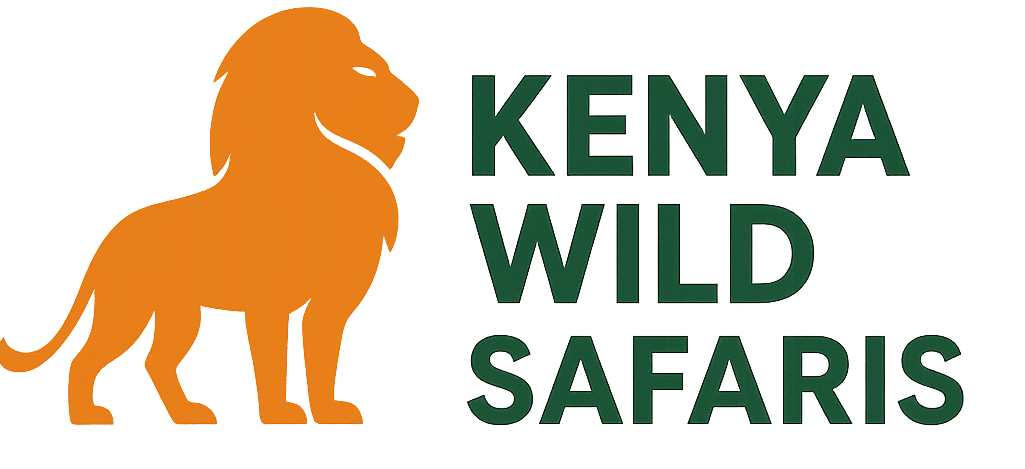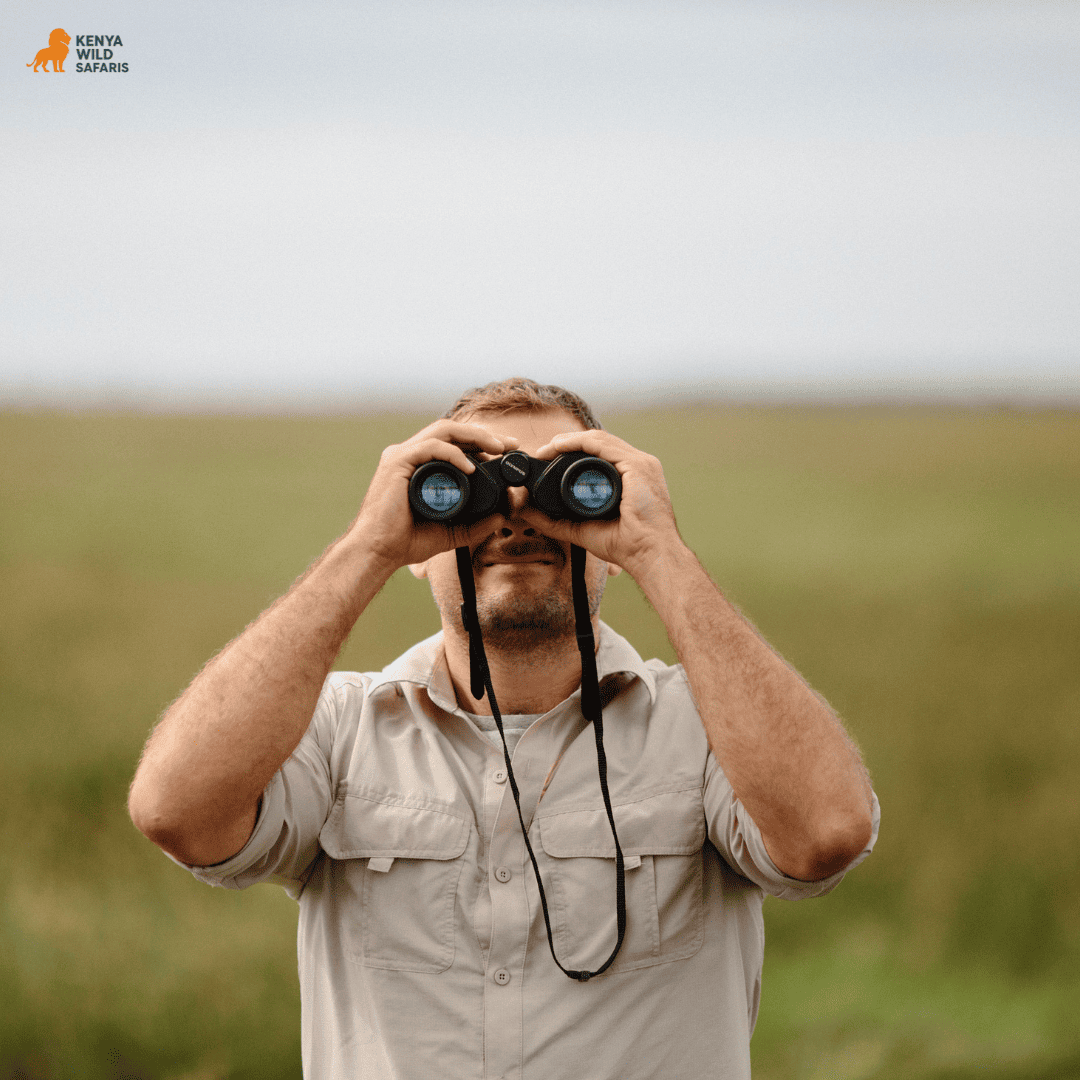The best binoculars for safari aren’t just a travel accessory; they are your passport to the most intimate and unforgettable wildlife viewing experiences. I recently returned from an epic safari in Kenya, a journey that took me from the dusty plains of Amboseli to the vast, predator-rich savannas of the Masai Mara and the flamingo-lined shores of Lake Nakuru. While I packed all the essential safari gear, I made a point of field-testing three popular binocular models to definitively answer the question: what binoculars to bring on safari?
The results were clear, and one model stood head and shoulders above the rest. If you’re planning your African adventure—whether it’s to Kenya, Tanzania, or beyond—read on. Your perfect view of the Big Five is about to get a whole lot closer.
Why Binoculars Matter More Than You Think on Safari
The term “safari” conjures images of majestic animals right next to your open-top vehicle. And while those moments do happen, the reality is that the most magical, rare, and crucial sightings often occur at a distance. This is where high-quality wildlife viewing binoculars become indispensable.
The Cost of Missing the Small Details
Imagine a leopard, perfectly camouflaged, draped over a distant acacia branch. Or a rare black rhino, a tiny dark speck on the horizon. Without a good pair of optics, these fleeting moments—the very highlights of your trip—remain just that: specks. Missing the small details—the flicker of a lion’s tail, the iridescent shimmer of a starling, the tenderness of an elephant matriarch guiding her calf—can dilute the wonder of the experience.
Personal story: “On my first safari, years ago, I thought my camera zoom was enough. I quickly learned the error of my ways. My camera was heavy, slow to focus, and provided a narrow, shaky view. I missed the distinct markings on a distant cheetah because I couldn’t quickly find it in my frame. It wasn’t until a seasoned guide handed me his binoculars that I truly appreciated the difference. Binoculars offer an immediate, immersive, and stable view that no camera screen can replicate.”
Brief Overview: What Makes a Safari Binocular Different?
A high-performing binoculars for Kenya / Africa need a specific set of characteristics to handle the unique challenges of the African bush:
- Clarity & Brightness: Early morning and late afternoon game drives are the best for viewing, but they are also low-light conditions. You need lenses that gather as much light as possible.
- Durability & Weather Sealing: Safari environments are tough. You need waterproof safari binoculars that can withstand torrential downpours, relentless dust, and the inevitable bumps of rough terrain.
- Portability: You’ll be wearing or holding these for hours on end. Lightweight safari binoculars are non-negotiable for comfort.
This comprehensive test focused on finding the perfect blend of these traits for the average traveler.
The 3 Binoculars I Tested on Safari
I chose three models across a range of specifications and price points for this binocular comparison safari. I carried each one extensively across my 10-day trip, switching them out during different game drives and conditions to truly understand their strengths and weaknesses in a real-world setting.
Safari Binoculars (Product 1) — Vortex Optics 12×50 Diamondback HD

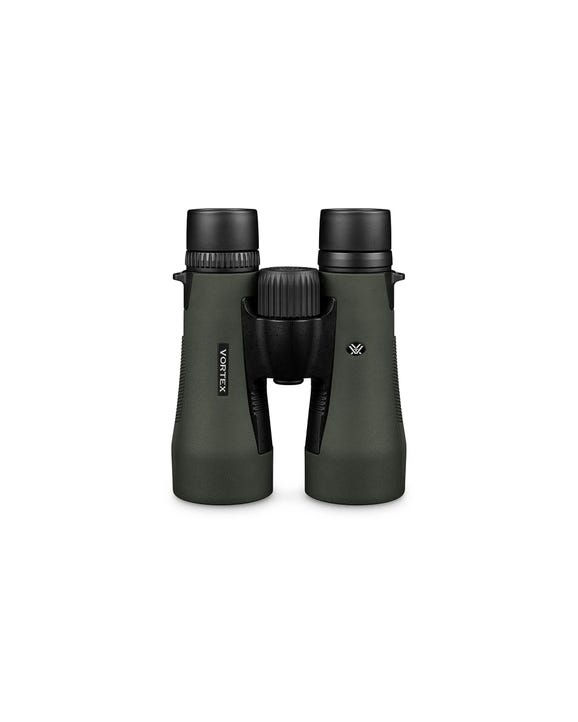
The Vortex Diamondback series is an extremely popular choice, known for its value and robust build. I opted for the 12×50 model to test the limits of high magnification on a game vehicle.
Key Features & Specs Summary
- Magnification/Objective: $12\times50$ (12x power, 50mm objective lens)
- Prism Type: Roof Prism
- Key Features: HD Optical System, Fully Multi-Coated Lenses, Argon Purged (Fogproof), Waterproof, Rubber Armor.
What I Liked: Strong Magnification, Durable, Good Image Quality
The $12\times$ magnification was fantastic for spotting very distant wildlife, particularly in the open plains of Amboseli National Park. I could clearly make out the tusks of an elephant herd that looked like pinpricks to the naked eye. The image quality, especially for the price point, was sharp and the colors were true. They felt incredibly durable and well-armored—ready to take a beating on a bumpy track.
What I Didn’t Like: Heavy and Less Practical for Handheld Use
The $12\times50$ configuration is heavy. Weighing in at nearly 30 ounces (about $850$ grams), they became cumbersome to wear around my neck for extended periods, and I frequently had to put them down. More critically, the $12\times$ magnification was difficult to keep steady, even when resting my elbows on the vehicle’s edge. This resulted in a constantly shaking image, making it hard to track a moving animal or enjoy a still moment without a stand.
Verdict: Great for Static Use or Photographers, but Bulky for Daily Safaris
The Vortex Diamondback $12\times50$ are powerful optics, but their bulk and high magnification make them impractical for most travelers. They’re best suited for a serious photographer who plans to mount them on a tripod or a dedicated birder who prioritizes extreme range over comfort and stability. For quick, frequent spotting on a typical game drive, they are simply too much.
Safari Binoculars (Product 2) — Nocs Provisions Pro Issue 8×42 (Recommended)
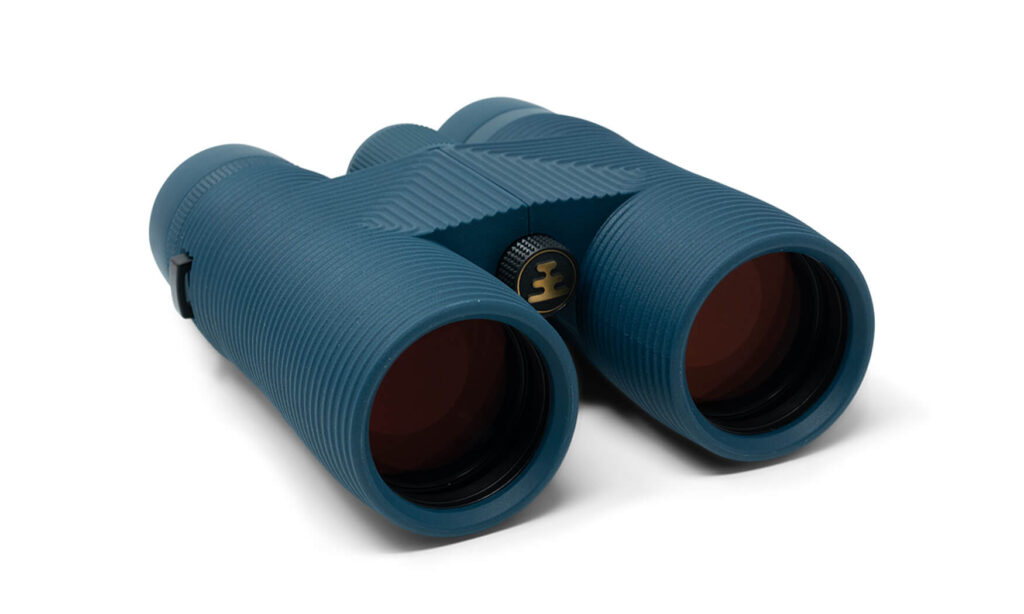
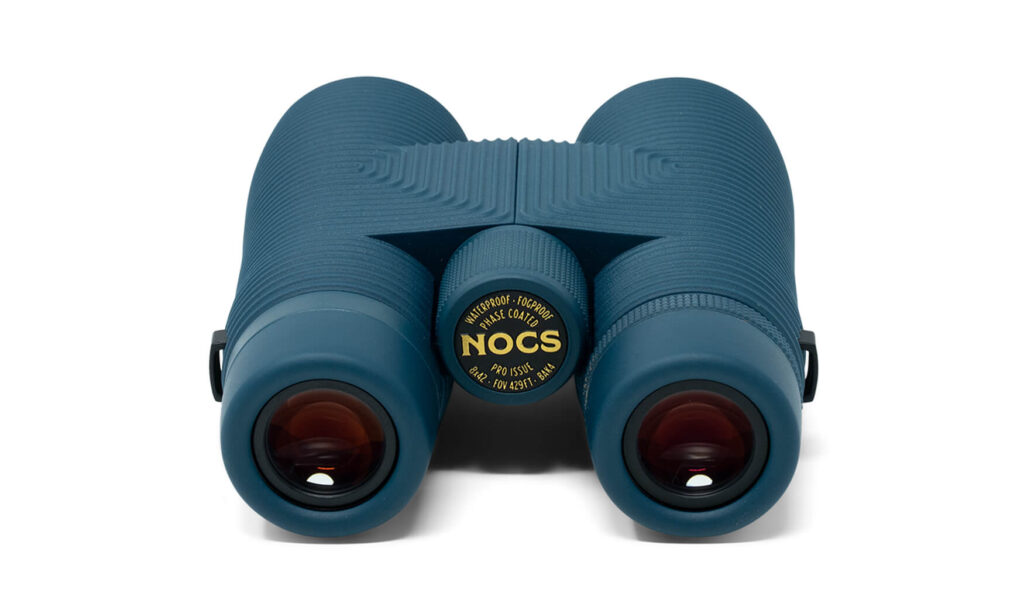
Based on countless hours of research into the perfect travel gear for Africa safaris, I brought the Nocs Provisions Pro Issue $8\times42$ as my main contender. The $8\times42$ configuration is often cited as the ‘gold standard’ for general safari binoculars.
Why It Stood Out: Perfect Balance Between Clarity, Comfort & Design
From the moment I picked them up, the Nocs Provisions Pro Issue felt right. They struck an optimal balance of clarity, a wide field of view, and comfortable, portable design. They didn’t just feel like a piece of gear; they felt like a natural extension of my eyesight. This model is truly optimized for the traveler who needs high performance without the bulk of professional hunting optics.
Key Highlights:
- Wide Field of View – Ideal for Scanning Moving Herds: The $8\times$ magnification provides an exceptionally wide view. This made it effortless to sweep across the vast Masai Mara savanna and instantly locate a lion stalking a herd or track a flock of flamingos taking flight on Lake Nakuru. This wider field of view is a massive advantage over the narrower $12\times$ view.
- Fogproof & Waterproof – Survived Amboseli Dust & Nakuru Rain: They boast an IPX7 waterproof rating and are nitrogen-sealed to be fogproof. The rubberized housing handled the fine, pervasive dust of Amboseli National Park without a single issue and provided a clear view even when a sudden shower hit us near Lake Nakuru. This waterproof safari binoculars durability makes them genuinely adventure-proof.
- Super Lightweight – Easy to Carry All Day: At about $1.5$ lbs (about $680$ grams), they are considerably lighter than the Vortex $12\times50$. I could wear them all day with a comfortable neck strap and almost forget they were there until the next sighting. This is a critical factor in a binocular buying guide for travelers.
- Excellent Color Accuracy – True-to-Life Wildlife Tones: The Pro Issue’s phase-corrected BaK4 prisms and multilayer coatings provided outstanding image sharpness and color. I could distinguish the subtle reddish-brown dust on a Tsavo elephant or the precise feather patterns of a roller bird—the view was bright and rich, especially in the crucial low-light periods of dawn and dusk.
Personal Note: “These felt like an extension of my eyes.”
The ease of use and rapid focus wheel meant I could go from spotting a subject to having a crystal-clear, steady view in a second. They truly enhanced every single game drive.
Perfect For: Travelers, Birders, and First-Time Safari-Goers
If you want the best combination of optical quality, portability, and ruggedness for your trip, the Nocs Pro Issue $8\times42$ is, in my professional opinion, the benchmark for the best binoculars for safari.
Safari Binoculars (Product 3) — Nocs Field Tube 8×32 Monocular
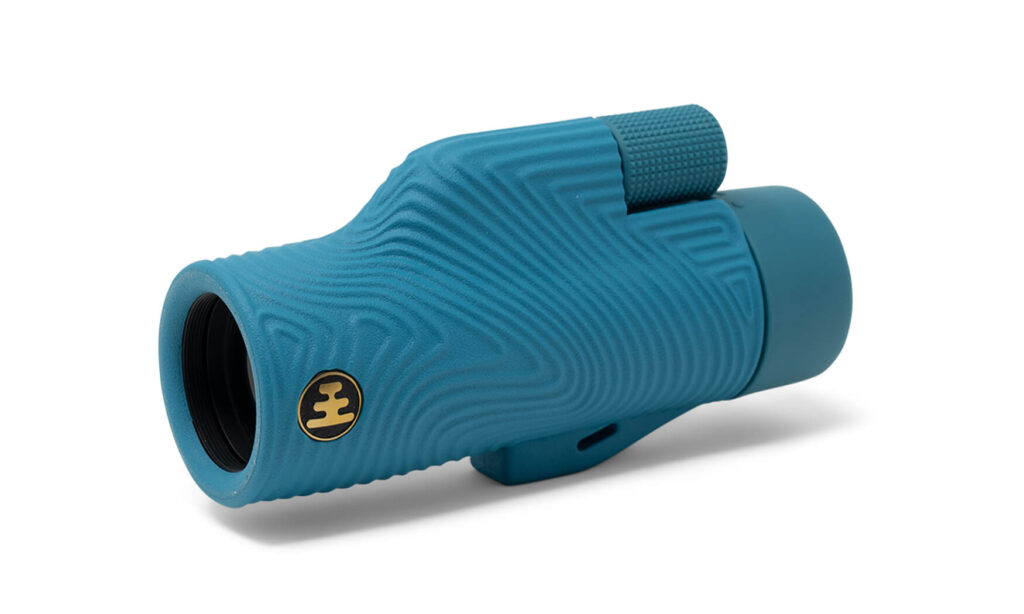
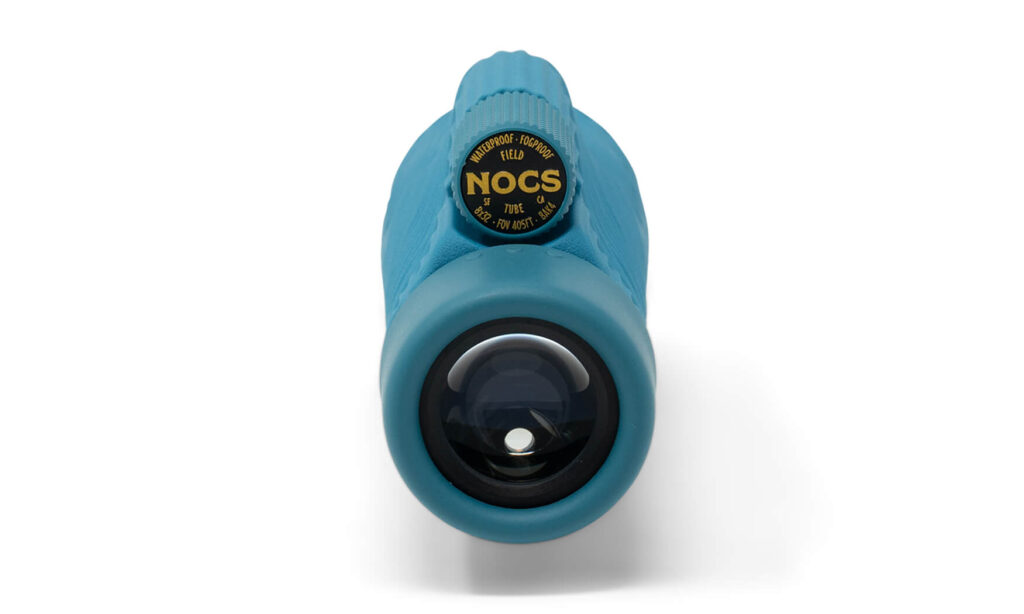

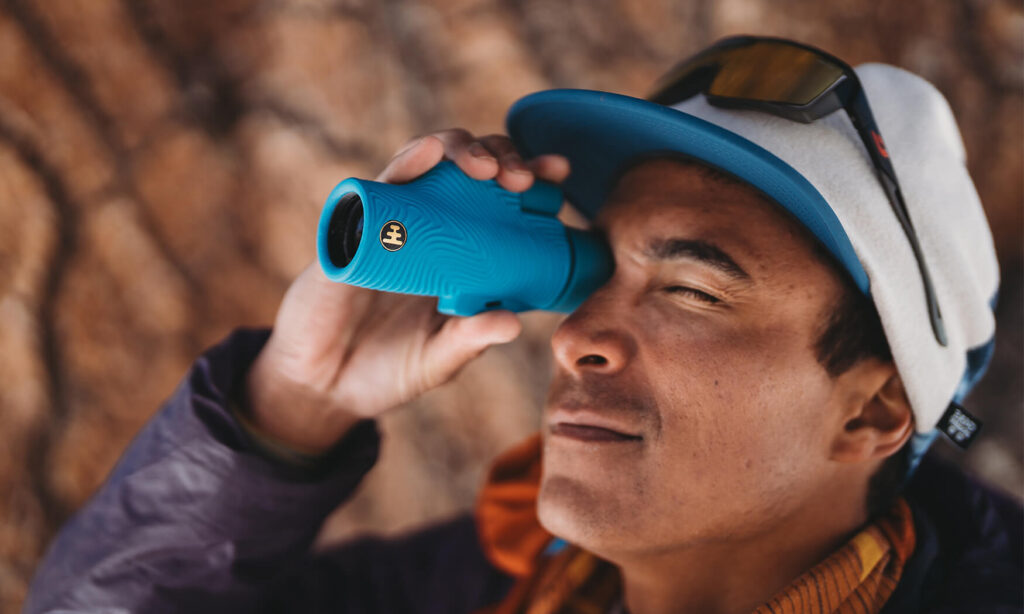
For the minimalist traveler, I tested a highly portable, single-lens alternative: the Nocs Field Tube $8\times32$ monocular.
Great Portability but Lacks Immersive Field Depth
The monocular is unbelievably light and compact, easily slipping into a jacket pocket or the smallest day pack. The $8\times32$ specs provided a clear, bright image, making it excellent for quick checks or city sightseeing.
Best for Minimalist Travelers or Quick Hikes
If your trip includes a lot of walking safaris, or if space and weight are your ultimate priority (perhaps you are an extreme backpacker), this is a solid, albeit simple, piece of gear.
Why I Didn’t Recommend It for Serious Wildlife Viewing
The single-eye view, while portable, lacks the comfortable, immersive depth perception you get with a binocular. For serious wildlife viewing binoculars where you are scanning a wide, open area for hours and need to quickly gauge distance, a monocular simply doesn’t offer the same rich, three-dimensional experience. It’s a good supplement, but not a replacement for full binoculars on a primary game drive.
The Winner — Nocs Provisions Pro Issue 8×42
After testing three excellent, but distinctly different, optical tools in the demanding environment of the Kenyan savanna, the Nocs Provisions Pro Issue 8×42 emerged as the undisputed champion. It is the definitive answer to the question of the best binoculars for safari.
Recap: Clear, Comfortable, Travel-Proof
The Nocs Pro Issue simply outperformed the others where it mattered most:
- Clarity: Edge-to-edge sharpness and superior low-light performance thanks to its phase-coated prisms.
- Comfort: The optimal $8\times$ magnification eliminated the hand-shake issue of the $12\times$ model and the lightweight build made all-day carry effortless.
- Travel-Proof: The IPX7 waterproofing and rugged, ribbed grip made it perfectly suited for the dust, rain, and inevitable rough handling of an African game drive.
Safari-Tested Durability (Masai Mara & Lake Nakuru Conditions)
The Nocs survived being bounced around in the Land Cruiser across the rutted tracks of the Masai Mara. They withstood the chilly, damp conditions of a pre-dawn viewing at Lake Nakuru National Park without fogging. This isn’t just lab-tested durability; this is safari-tested durability.
Value for Money: Comparable to $1,000 Models but Affordable
What truly sets the Nocs Provisions Pro Issue apart in any binocular comparison safari is its incredible value. While not the cheapest option on the market, the optical clarity and build quality compete directly with models from premium European brands that often cost two or three times as much. For a traveler, this binocular delivers professional-grade viewing without the professional-grade price tag.
Why It’s the Sweet Spot Between Price, Performance, and Portability
The Nocs Provisions Pro Issue 8×42 review confirms its status as the “sweet spot” in the market. It masterfully blends the essential optical requirements for serious wildlife viewing (bright, clear image, wide field of view) with the non-negotiable practical needs of a traveler (lightweight, durable, and weather-sealed). If you’re looking for the best all-around performer that won’t strain your neck or your wallet, this is the one.
What to Look for When Buying Safari Binoculars
Understanding the technical specifications is key to selecting the right safari gear recommendations. This educational section serves as a crucial binocular buying guide for travelers heading to Africa.
Magnification: $8\times$ vs $12\times$ for Wildlife Tracking
- $8\times$ (Recommended for Safari): The image appears $8$ times closer. This provides a wider field of view, brighter image, and is significantly easier to hold steady. This is crucial for tracking a moving animal or quickly spotting a subject in the bush.
- $12\times$ (Use with Caution): The image appears $12$ times closer, but the field of view is much narrower, the image is dimmer, and any hand shake is amplified, making the view unstable. Best only for long-range, static viewing with a mount.
Lens Diameter: How It Affects Brightness
The second number (e.g., the ‘$42$‘ in $8\times42$) is the objective lens diameter in millimeters. A larger lens gathers more light, resulting in a brighter, clearer image, especially in low-light conditions like dawn or dusk—the best times for wildlife activity. $42$mm is generally considered the optimal size for a full-size safari binocular, offering excellent light gathering without excessive weight.
Weight & Grip: Comfort During Long Game Drives
Remember, a game drive can last up to four hours. Heavy binoculars can become a burden. Aim for a weight of $2$ pounds or less. A textured or rubber-armored grip, like that on the Nocs Provisions, is also essential for a secure hold, especially in humid or dusty conditions.
Weather Sealing: Fogproof & Waterproof Explained
- Waterproof: The optics are sealed with O-rings to prevent moisture from entering. Look for an IPX rating (IPX7 is excellent, meaning it can withstand submersion). This protects against rain and high humidity.
- Fogproof: The interior air is replaced with inert gas (usually nitrogen or argon). This prevents internal lens fogging when transitioning between temperature extremes (e.g., taking them out of an air-conditioned lodge into the hot, humid air). This is non-negotiable for waterproof safari binoculars.
Field of View (FOV): Why Wider is Better in Open Savannahs
Field of View (FOV) is the width of the area you can see through the binoculars at a specified distance (usually $1,000$ yards). A wider FOV (look for $390$ feet or more at $1,000$ yards) makes it exponentially easier to locate animals quickly, follow a bird in flight, or scan an entire herd of wildebeest—all crucial activities on the vast, open plains of a place like the Masai Mara.
My Field Tips for Using Binoculars on Safari
Owning the best binoculars for safari is only half the battle. Knowing how to use them effectively will maximize your sightings.
How to Quickly Focus on a Moving Animal
- Spot it with the naked eye: Don’t try to find a moving animal by looking through the binoculars first. Find the animal with your eyes and keep them on it.
- Bring the binoculars up: Lift the binoculars to your eyes without moving your head from the target. You should be looking close to the target, or at least in the right area.
- Refine Focus: Use the central focus wheel to quickly bring the subject into sharp focus. With the wide FOV of an $8\times42$ like the Nocs Pro Issue, this process should take just seconds.
Avoiding Shaky Hands (Use Car Roof or Beanbag)
High magnification amplifies shaking. If you have a pair of $10\times$ or $12\times$ binoculars, or if you simply can’t hold your $8\times$ steady for a long time, use the vehicle to your advantage:
- Rest your elbows on the edge of the car’s roof railing.
- Lean your forehead against the soft rail padding.
- Bring a small beanbag or a specialized binocular harness to stabilize and distribute the weight better than a simple neck strap.
Don’t Forget Lens Wipes and Neck Straps
Dust is the enemy of optics in Africa. Always carry a microfiber lens cloth (not a tissue or your shirt!) and a lens brush. A wide, padded neck strap or a binocular harness will make all-day use far more comfortable than a thin strap.
Best Time of Day for Viewing Clarity
Wildlife is most active, and therefore viewing is at its peak, during the ‘Golden Hours’—early morning (just after sunrise) and late afternoon (before sunset). While low light demands quality optics, the angle of the sun at these times is also softer and less glaring, offering the best natural contrast and color. Always be mindful of pointing your binoculars toward the bright sun, as this can damage the lens coatings and, more importantly, your eyes.
Final Thoughts — The Binocular I’ll Take on Every Safari
Choosing the right optics is one of the most important safari gear recommendations you will receive. It is the difference between seeing a blur and seeing the soul of the wild.
I can confidently restate the winner: Nocs Provisions Pro Issue 8×42.
Honest Final Take: If I could pack only one pair for my next safari—it’s this one.
The Nocs Pro Issue $8\times42$ delivers exceptional performance, rugged durability, and all-day comfort, all at a price point that makes premium optics accessible. It completely elevated my experience in the wild heart of Kenya, turning distant specks into vibrant, unforgettable moments. Stop searching for the perfect gear and start focusing on the adventure.
If you’re planning your first safari, grab these before your trip.
Don’t risk having your most treasured sighting reduced to a faraway shadow. Invest in a pair of binoculars that truly deliver on their promise.
👉 Buy the Nocs Provisions Pro Issue 8×42 Here
Frequently Asked Questions (FAQs) on Safari Binoculars
Q1: Is $8\times$ or $10\times$ magnification better for general safari use?
For the vast majority of travelers and general wildlife viewing, $8\times$ magnification is better. The $8\times$ power provides a wider field of view, a brighter image, and is significantly easier to hold steady from a moving or stationary game vehicle. This allows for quicker spotting and more comfortable, prolonged viewing. A $10\times$ model is only recommended if you are an experienced binocular user, a dedicated birder, or frequently plan to view very distant, static subjects.
Q2: How important is it that my binoculars are waterproof and fogproof for an Africa safari?
It is highly important. Africa is a place of extremes. You will encounter fine, pervasive dust in the dry season and torrential, sudden downpours in the wet season. Waterproof and fogproof (nitrogen-purged) binoculars ensure that dust and moisture cannot enter and ruin the delicate optics, and that your view remains clear when you take them out in the cool, early morning air. Look for an IPX7 rating for peace of mind.
Q3: Do I need a binocular harness or is a simple neck strap enough?
While a basic neck strap is sufficient, a binocular harness is highly recommended for a superior experience. A harness distributes the weight of the binoculars across your shoulders and back, rather than concentrating it on your neck, making all-day use much more comfortable. It also holds the binoculars securely to your chest, preventing them from swinging and potentially hitting something when you lean out of the vehicle.
Q4: What do the numbers $8\times42$ mean, and why is that combination ideal?
The numbers $8\times42$ describe the key specifications:
- $8\times$ (Magnification): The object appears $8$ times closer than the naked eye.
- $42$ (Objective Lens Diameter): The front lenses are $42$ millimeters in diameter.This combination is ideal because $8\times$ is easy to hold steady and offers a wide field of view, while the $42$mm lenses gather ample light for bright, clear images in all safari lighting conditions. It’s the perfect balance of power, light, and portability for a full-sized best binoculars for safari.
Discover the Wild Heart of Africa with Kenya Wild Safaris
Now that you have the perfect safari gear recommendations to clearly see every detail of the African wilderness, it’s time to choose the journey of a lifetime.
Kenya Wild Safaris specializes in curating authentic, breathtaking safari experiences across the magnificent landscapes of Kenya. From tracking the Big Five in the legendary Masai Mara National Reserve to witnessing the vast elephant herds of Amboseli against the backdrop of Mount Kilimanjaro, and exploring the unique birdlife of Lake Nakuru, our expertly guided tours ensure you are positioned for optimal wildlife viewing.
Our custom-built, open-top safari vehicles and knowledgeable local guides are dedicated to bringing you safely and comfortably to the heart of the action. Don’t just book a trip; embark on a profound adventure that connects you with nature.
Ready to use your Nocs Provisions Pro Issue $8\times42$ to full effect?
Explore our premier Kenya safari packages and start planning your perfect wildlife adventure today!
